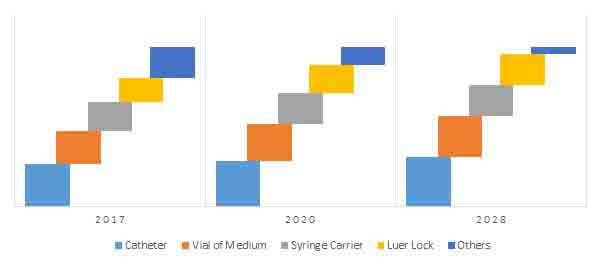Sperm Preparation Kits Market Segmented By component that is Catheter, Vial of Medium, Syringe Carrier, Luer Lock used in Hospitals, Clinics, Fertility Centers.
Industry: Healthcare
Format: PPT*, PDF, EXCEL
Delivery Timelines: Contact Sales
Report Type: Ongoing
Report ID: PMRREP22894
Infertility is a growing concern among the developed and developing countries. According to the Centers for Disease Control and Prevention (CDC), 12.1% of women aged 15–44 years suffer from impaired fecundity and 6.7% of married women aged 15–44 years suffer from infertility.
In 2016, 7.3 million women aged 15–44 years used infertility services in the U.S. A paradigm shift has been observed towards clinically assisted reproduction among general population due to rising prevalence of infertility. Over the past decade, there has been a surge in developing sophisticated techniques from andrological indications to separate active spermatozoa and in replacing the immotile and infertile spermatozoa.
Fertilization and embryogenesis highly depend on the integrity of male gamete and it has led to increased demand for sperm separation techniques. Under in vivo conditions, potential spermatozoa is separated from seminal plasma and is used in fertilization. During the process of spermatozoa separation, motile spermatozoa with capacitation are used for acrosome reaction.
The introduction of assisted reproduction techniques led to the development of different sperm separation methods. On principle, spermatozoa are separated by density gradient centrifugation, migration, and filtration. In the migration method, spermatozoa are self-propelled, and in filtration and centrifugation methods, spermatozoa are separated by adherence to filtration medium and retention at phase borders, respectively.
The migration technique is further divided into under-lay, swim-up, and migration-sedimentation techniques. Spermatozoa separation is a complex procedure and it recovers highly functioning sperm population. Serial centrifugation of sperm plasma leads to sperm dysfunction and immotile.
The rapid advancement of technology leads to gentle sperm separation through the swim-up procedure and double density centrifugation. The spermatozoa selection depends on motility, viability, and morphology. The success rate of separation with swim-up procedures and double density centrifugation is very high compared to the conventional methods.

Rising prevalence of infertility among the general population is expected to boost the growth of the sperm preparation kits market. According to the National Institute of Child Health and Human Development, about 9% of men and 11% of women in the reproductive age in the U.S. have some kind of fertility disorders. In-vitro fertilization and intracytoplasmic sperm injection is a best available treatment for infertility.
Rising demand for effective treatments along with government initiatives to control infertility in developed regions is expected to boost the growth of the sperm preparation kits market. Apart from this, raising awareness regarding the treatment options is also expected to contribute to the growth of the sperm preparation kits market.
Manufacturers of sperm preparation kits are majorly focused on product augmentation to decrease the risk of cross-contamination and errors in the spermatozoa collection procedures.
A significant portion of the market is been covered by catheter, vial of medium, syringe carrier, luer lock and others segments. Catheters and Vials segments collectively hold largest revenue share in the market, due to high adoption rate.
Moreover, the awareness towards drawbacks such as cross-contamination of conventional techniques and benefits of sperm preparation kits lead to strong positioning of these segments in the overall market.
Hospitals and fertility centers segments pose a strong position in the market due to high acceptance among the patients. However, continuing growth of assisted reproduction techniques to control infertility among the developed regions is expected to boost the growth of the sperm preparation kits market.
Further, raising awareness among the end users and increasing prevalence of infertility are expected to boost the growth of the sperm preparation kits market.
North America will continue to dominate the global market due to the high penetration among the customers as well as end users. Europe is expected to hold second large market share in the global sperm preparation kits market due to growing awareness.
Examples of some of the players identified in the global Sperm Preparation Kits market are Cook Medical, Nidacon International AB, Cooper Surgical, Inc., Vitrolife, Cryo-Genie India Pvt. Ltd., Irvine Scientific., and Cryos International - Denmark ApS, etc. Increasing focus on growing demand for efficient sperm separation techniques in various developed countries is expected to fuel the need for rising infertility.
The sperm preparations kits enable reductions in cross-contamination, convenience, safety and reduce patient time in healthcare centers. Increasing government funding for research in the advanced medical treatment of infertility and target-specific delivery with concern to the safety of patients is expected to drive the revenue growth of global prefilled saline syringes market.
| Small Scale Manufacturers/Providers |
|
| Medium Scale Manufacturers/Providers |
|
| Large Scale Manufacturers/Providers |
|
The report covers exhaustive analysis on:
| By Component |
|
| By End-user |
|
|
Region |
|
The market sizing of sperm preparation kits is done by the adoption data triangulation approach. The demand-side approach is followed to assess the actual market size of sperm preparation kits. Secondary research is used at the initial phase to identify the feasibility of the target products/technology categories and its respective segments, product and service offerings, in end-use facilities, adoption rate and future impact of new technologies.
Additionally, per capita consumption of syringes among end users is tracked at a granular level to obtain the most accurate information. Each piece of information is eventually analyzed during the entire research project, which helps build a strong base for the primary research information.
Primary research participants include demand-side respondents such as laboratory managers, procurement managers, research supervisors, as well as key opinion leaders in addition to supply-side respondents such as equipment manufacturers, custom solution and service providers who provide valuable insights on trends, research application of products and technologies, purchasing patterns, services offered and associated pricing.
To know more about delivery timeline for this report Contact Sales
